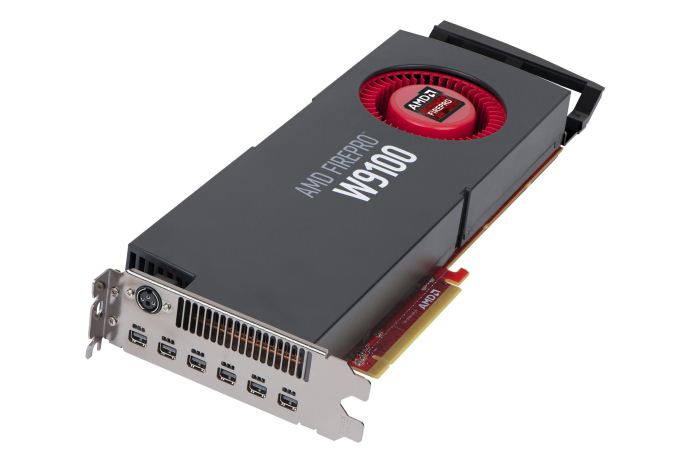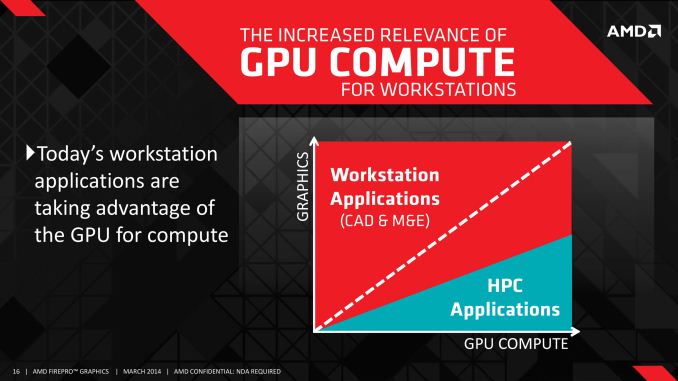AMD Launches FirePro W9100
by Ryan Smith on April 7, 2014 8:00 AM EST
Kicking off this week is the 2014 NAB Show, the National Association of Broadcasters’ annual trade show for broadcast content and technology. The NAB Show is often a launch point for new video products and this year is no exception, with AMD using the show to launch their new FirePro W9100.
First announced last month, the FirePro W9100 is AMD’s new flagship FirePro video card. Based on AMD’s Hawaii GPU, the FirePro W9100 is a fairly straightforward update to AMD’s FirePro lineup, bringing with it the various GCN 1.1 feature upgrades along with Hawaii’s stronger overall performance and greatly improved double precision (FP64) performance.
| AMD FirePro W Series Specification Comparison | ||||||
| AMD FirePro W9100 | AMD FirePro W9000 | AMD FirePro W8000 | AMD FirePro W7000 | |||
| Stream Processors | 2816 | 2048 | 1792 | 1280 | ||
| Texture Units | 176 | 128 | 112 | 80 | ||
| ROPs | 64 | 32 | 32 | 32 | ||
| Core Clock | 930MHz | 975MHz | 900MHz | 950MHz | ||
| Memory Clock | 5GHz GDDR5 | 5.5GHz GDDR5 | 5.5GHz GDDR5 | 4.8GHz GDDR5 | ||
| Memory Bus Width | 512-bit | 384-bit | 256-bit | 256-bit | ||
| VRAM | 16GB | 6GB | 4GB | 4GB | ||
| Double Precision | 1/2 | 1/4 | 1/4 | 1/16 | ||
| Transistor Count | 6.2B | 4.31B | 4.31B | 2.8B | ||
| TDP | 275W | 274W | 189W | <150W | ||
| Manufacturing Process | TSMC 28nm | TSMC 28nm | TSMC 28nm | TSMC 28nm | ||
| Architecture | GCN 1.1 | GCN 1.0 | GCN 1.0 | GCN 1.0 | ||
| Warranty | 3-Year | 3-Year | 3-Year | 3-Year | ||
| Launch Price | $3999 | $3999 | $1599 | $899 | ||
At the time of the FirePro W9100 announcement AMD did not announce the complete specifications or the price, but with today’s launch we finally have that information in hand. As expected, the W9100 will be utilizing a full-fledged Hawaii GPU, meaning all 2816 SPs and 64 ROPs are active. AMD will be clocking the card at 930Mhz, a slightly more conservative clockspeed than their consumer parts, but par for the course for these workstation parts. The tradeoff being that AMD will be able to ship it with a typical board power of just 275W, virtually unchanged from the 274W rating for the FirePro W9000.
From a raw specification standpoint AMD is going to be pushing memory bandwidth and memory capacity, and for good reason. The W9100 is outfit with 16GB of memory and will be utilizing Hawaii’s full 512-bit memory bus, giving it more RAM than any prior workstation card and 320GB/sec of memory bandwidth to access that RAM through. Meanwhile on a technical note, from the product details we’ve seen it looks like AMD is using 8Gb GDDR5 memory chips, which would mean the W9100 will be in a 16x8Gb memory configuration.
Also confirmed with today’s launch is W9100’s double precision floating point performance. We had earlier speculated based on AMD’s generalized double precision performance numbers that an unrestricted Hawaii GPU was capable of ½ speed double precision performance, and AMD has since confirmed that. This puts W9100 at 5.24 TFLOPS of single precision performance and 2.62 TFLOPS of double precision performance, making it the first workstation card to offer more than 2 TFLOPS of double precision performance.
Meanwhile as for pricing, AMD has set the MSRP on the W9100 at $3999. Unsurprisingly this is the same price as the W9000 when it launched roughly a year and a half ago, making the W9100 the W9000's replacement in every sense of the word. This also happens to continue the trend of AMD significantly undercutting NVIDIA’s workstation card prices, with the W9100 coming in roughly $1000 below the price of the Quadro K6000.
Wrapping things up, as we mentioned back in our initial look at AMD’s announcement, expect to see AMD heavily push the W9100 on the basis of its memory and compute performance alongside its graphics performance. While traditional graphics-heavy professional applications (e.g. AutoCAD) are still as power hungry as ever, the amount of compute work being generated by these programs is increasing. This goes for both programs using compute in a more straightforward way, and programs leveraging compute for graphics related tasks such as video encoding and image processing. For both of these tasks AMD is banking on their 16GB of VRAM giving them a performance advantage due to the larger working sets such a large memory configuration can hold, in turn allowing them to better utilize the full compute capabilities of the Hawaii GPU. Which on that note, AMD OpenCL users will be happy to hear that AMD has set a release window of Q4 for their OpenCL 2.0 driver for FirePro, a long-awaited release that among other things will introduce dynamic parallelism into OpenCL.











20 Comments
View All Comments
nathanddrews - Monday, April 7, 2014 - link
AT doesn't really do much in the way of workstation cards, right? Do you think you'll still get one to test in any way?daku123 - Monday, April 7, 2014 - link
Yes. Nvidia has captured almost 95% of market share in Workstation cards. RAW Performance wise 9100 looks promising. But ATI drivers are not properly tweaked for workstation business!piroroadkill - Monday, April 7, 2014 - link
Isn't this just a random and pointless myth that always persists?I know people with Dell Precision workstations and FirePro cards that never report graphics related issues.
Kevin G - Monday, April 7, 2014 - link
My experiences with FirePro's in the professional market have been tied to specific hardware/driver combinations through a 3rd party OEM. This means using older GPU hardware and nearly as old drivers to run in a 'certified' manner. While not hardware or software lock-in, it is support lock-in. That means a whole slew of new hardware features and bug fixes are out there but they'd be unsupported in the environment.extide - Monday, April 7, 2014 - link
Old Drivers is par for the course in this market, even on the nVidia side.daku123 - Monday, April 7, 2014 - link
I didn't mean people don't use FirePro at all. I have used both ATI FirePro and NVIDIA Quadro boards personally. OpenGL driver performance of Quadro is better than FirePro. In addition to that, extra perks like OptiX (for DCC) and most of the CUDA based tools are a much plus. I am using Quadro for DCC related work and they are much better in terms of performance and user experience!P.S.: All Oscar nominated Animated movies are made on Quadros!
teldar - Tuesday, August 12, 2014 - link
So... You're saying that only movies made on Quadros go on to get nominations? I wonder how much nVidia pays for that.TeXWiller - Monday, April 7, 2014 - link
Yes it is, according to my anecdotal observations :). There are "critical mass" and availability issues for these products. The performance and reliability differences between FirePro and Quadro seem to show up the same way as for the gaming cards, title by title basis.PEJUman - Monday, April 7, 2014 - link
I am guessing those guys with Precisions & FirePro are not running specialized software. I have a Quadro K4000M, it is quite flaky when working with new professional 3D package. I had to switch drivers back and forth to get the new package & solidworks to work.The whole time NVIDIA OPTIMUS kept on insisting on going to intel's HD for 2D display (idle desktop), which in turn puked when I un-docked the laptop. Apparently multiple screen does not work well with optimus.
The whole thing is quite bad actually, and I shudder to think about anyone who opted for the FirePro equipped Precision.
tipoo - Monday, April 21, 2014 - link
It's somewhat true, it's very application dependant. Those Firepro owners may never run into issues because they only use apps the drivers are optimized for. There are also a few apps that are *better* optimized for Firepro than Nvidia. It depends entirely on your workload if firepros will be good for you.